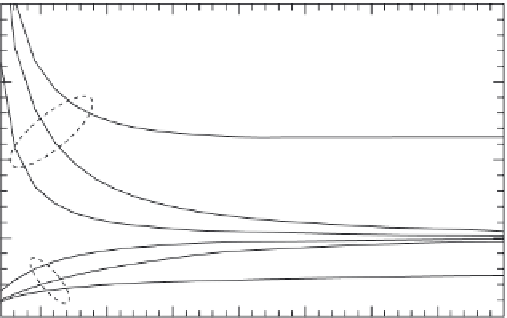Biomedical Engineering Reference
In-Depth Information
4
3
Cations
n
0
0.005 M
2
0.15 M
0.5 M
1
0.5 M
0.15 M
0.005 M
Anions
0
15
20
25
30
35
40
45
50
R
s
, Å
FIGURE 7.7
Ratio
n
ds
/
n
ss
of average concentration of cations (upper part of diagram) and ani-
ons (lower part of diagram) within the intermolecular spaces before hybridization
n
ss
and after hybridi-
zation
n
ds
in 1:1 salt solutions with bulk ion concentration of
n
0
0.005, 0.15 and 0.5 M, respectively.
R
s
: DNA cell radius.
of the average concentration for
cations and anions within the intermolecular spaces before hybridization
Figure 7.7 shows the calculated ratio
n
ds
/
n
ss
n
ss
and
after hybridization
is plotted as a function of the DNA
cell radius
R
s
and for 1:1 salt solutions of different bulk-ion concentrations of
n
0
0.005, 0.15 (physiological solution) and 0.5 M, respectively. The fraction of both the
ssDNA and dsDNA charge compensated by the condensed cations was taken as
n
ds
. The ratio
n
ds
/
n
ss
θ
0.8. Two effects can be recognized from Fig. 7.7:
●
the local concentration of cations and anions within the intermolecular spaces
differs strongly from that of the bulk solution (a similar effect has been experi-
mentally observed for DNA brushes in [55]), and
●
the average ion concentration within the intermolecular spaces after the hybrid-
ization differs distinctly from that of before the hybridization; the effect is
dependent on the ionic strength of the bulk electrolyte solution and is stronger in
a low ionic-strength electrolyte.
In contrast to the DNA detection by its intrinsic molecular charge, even in high
ionic-strength solutions (0.5 M), where the hybridization effi ciency is high and the
hybridization event can be faster, a detectable sensor signal can be achieved. The esti-
mations performed under the assumptions presented in Fig. 7.8 predict signal values of
about 28-35 mV.
The achieved biosensor signal will be infl uenced by the following factors:
●
an increase of
R
S
implies a decreased density of immobilized ssDNA yielding a
smaller
n
ds
/
n
ss
ratio (more strongly in high ionic-strength solutions),






Search WWH ::

Custom Search